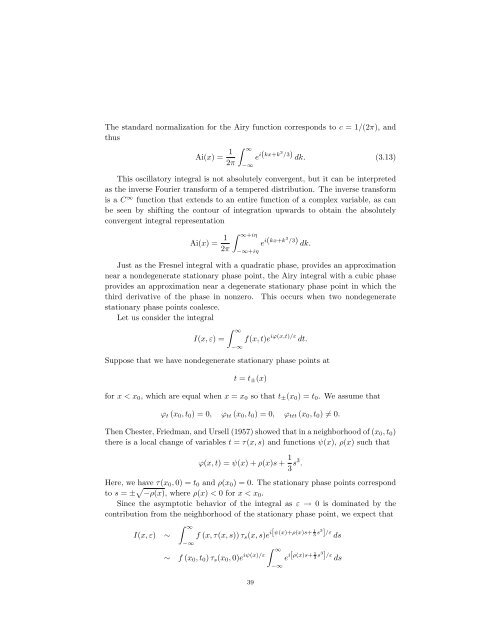Asymptotic Analysis and Singular Perturbation Theory
Asymptotic Analysis and Singular Perturbation Theory
Asymptotic Analysis and Singular Perturbation Theory
You also want an ePaper? Increase the reach of your titles
YUMPU automatically turns print PDFs into web optimized ePapers that Google loves.
The st<strong>and</strong>ard normalization for the Airy function corresponds to c = 1/(2π), <strong>and</strong><br />
thus<br />
Ai(x) = 1<br />
∞<br />
e<br />
2π −∞<br />
i(kx+k3 /3) dk. (3.13)<br />
This oscillatory integral is not absolutely convergent, but it can be interpreted<br />
as the inverse Fourier transform of a tempered distribution. The inverse transform<br />
is a C∞ function that extends to an entire function of a complex variable, as can<br />
be seen by shifting the contour of integration upwards to obtain the absolutely<br />
convergent integral representation<br />
Ai(x) = 1<br />
∞+iη<br />
e<br />
2π −∞+iη<br />
i(kx+k3 /3) dk.<br />
Just as the Fresnel integral with a quadratic phase, provides an approximation<br />
near a nondegenerate stationary phase point, the Airy integral with a cubic phase<br />
provides an approximation near a degenerate stationary phase point in which the<br />
third derivative of the phase in nonzero. This occurs when two nondegenerate<br />
stationary phase points coalesce.<br />
Let us consider the integral<br />
I(x, ε) =<br />
∞<br />
−∞<br />
f(x, t)e iϕ(x,t)/ε dt.<br />
Suppose that we have nondegenerate stationary phase points at<br />
t = t±(x)<br />
for x < x0, which are equal when x = x0 so that t±(x0) = t0. We assume that<br />
ϕt (x0, t0) = 0, ϕtt (x0, t0) = 0, ϕttt (x0, t0) = 0.<br />
Then Chester, Friedman, <strong>and</strong> Ursell (1957) showed that in a neighborhood of (x0, t0)<br />
there is a local change of variables t = τ(x, s) <strong>and</strong> functions ψ(x), ρ(x) such that<br />
ϕ(x, t) = ψ(x) + ρ(x)s + 1<br />
3 s3 .<br />
Here, we have τ(x0, 0) = t0 <strong>and</strong> ρ(x0) = 0. The stationary phase points correspond<br />
to s = ± −ρ(x), where ρ(x) < 0 for x < x0.<br />
Since the asymptotic behavior of the integral as ε → 0 is dominated by the<br />
contribution from the neighborhood of the stationary phase point, we expect that<br />
I(x, ε) ∼<br />
∞<br />
−∞<br />
1<br />
i[ψ(x)+ρ(x)s+<br />
f (x, τ(x, s)) τs(x, s)e 3 s3 ]/ε<br />
ds<br />
∼ f (x0, t0) τs(x0, 0)e iψ(x)/ε<br />
39<br />
∞<br />
−∞<br />
1<br />
i[ρ(x)s+<br />
e 3 s3 ]/ε<br />
ds
















